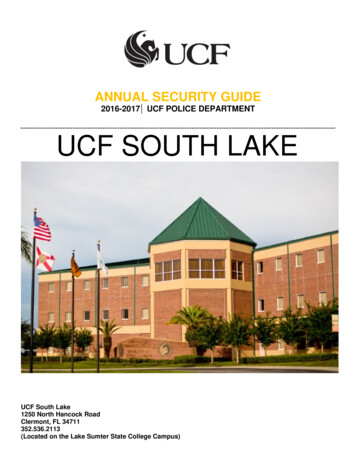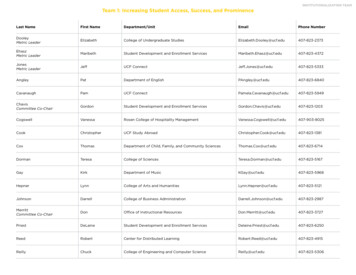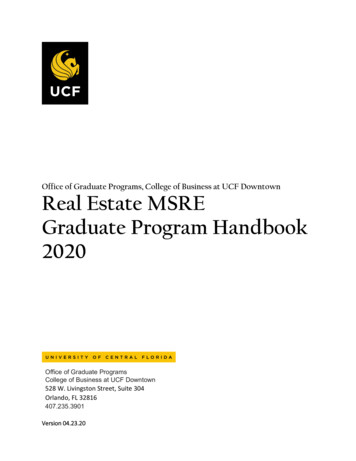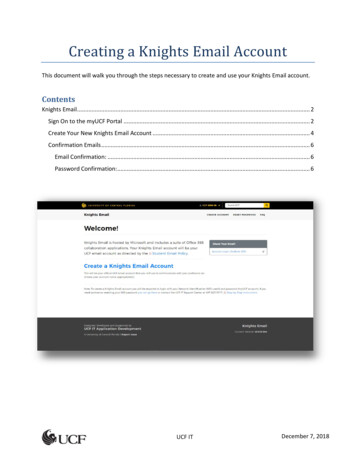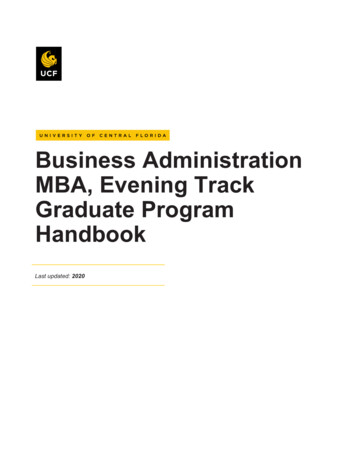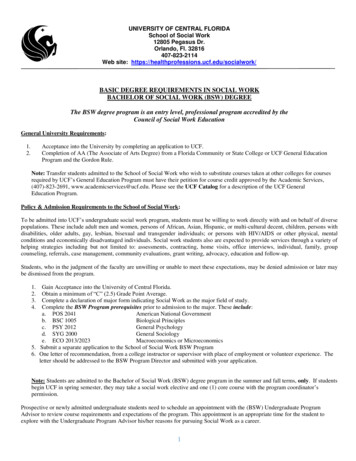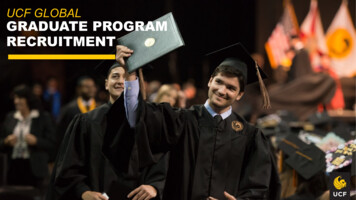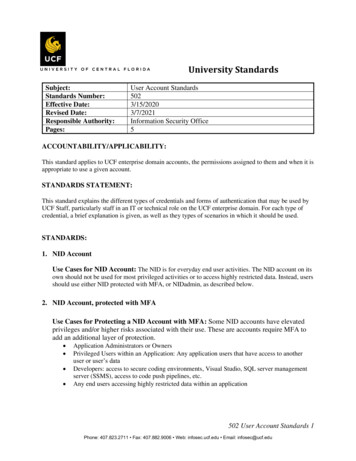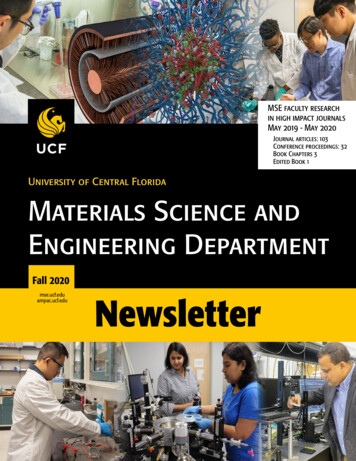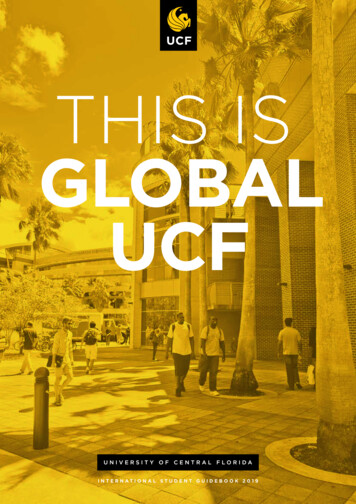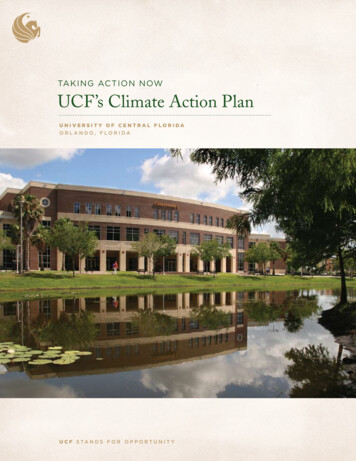
Transcription
Tak in g Ac t io n N owUCF’s Climate Action PlanUNIVERSITY OF CENTRAL FLORIDAORLANDO, FLORIDAU C F S t ands for o p p or t u ni t y
C on t en tsLong-Term Plan. . . . . . . . . . . . . . . . . . . . . . 2Timeline. . . . . . . . . . . . . . . . . . . . . . . . . . . 4The Full Report. . . . . . . . . . . . . . . . . . . . . 62008 Campus Emissions . . . . . . . . . . . . . . 8Structures, Plans & Policies. . . . . . . . . . . 9Becoming a Sustainable Campus . . . . . . 11Education & Community Outreach. . . . . 16Research. . . . . . . . . . . . . . . . . . . . . . . . . . . 21Financing and Tracking . . . . . . . . . . . . . 242
C L I M A T E AC T ION P L ANUCF is a Catalyst for Positive ChangeT h e U n i v ers i t y of Central Flor ida (UCF) is committed to providingthe Central Florida community and beyond with high-quality educationalexperiences, groundbreaking research, and practical solutions to some of theworld’s most urgent issues.At UCF, we know that the stabilization of the earth’s climate is one of those issues—and that’s why UCF has a plan for sustainability and has pledged to be climateneutral by 2050.In 2009, the university grew to become the largest university in the state of Floridaand the third-largest in the nation.1 With more than 53,000 students enrolled atits main campus and 11 regional campuses throughout the Central Florida region,the opportunity to make a significant impact on the environment and on ourcommunities—and the chance to protect that environment for future generations—is stronger than ever.Defining Sustainability and Climate NeutralityThe United Nations has defined sustainability as the integration of economic, social, andenvironmental interests which address the needs of both the current and of future generations.2The American College and University Presidents Climate Commitment (ACUPCC), ofwhich UCF President John Hitt is a founding member of its Leadership Circle, encouragesuniversities to pursue climate neutrality and integrate sustainability into their curriculum.ACUPCC defines climate neutrality as having no net greenhouse gas (GHG) emissions—orgases that cause the greenhouse effect—by minimizing these emissions as much as possibleand using carbon offsets, or other measures, to mitigate the remaining emissions.UCF’s Promise At-a-GlanceUCF isn’t alone in recognizing that one of the most critical issues facing the global communitytoday is climate change—prominent leaders across the globe have joined forces to confrontit together.In February 2007, UCF President John Hitt took a stand on climate change and pledgedthat UCF would become climate neutral by year 2050 at the latest. The university’s timeline isto reduce its carbon dioxide emissions by at least 17 percent by 2020 and by 42 percentby 2030.UCF’s plan is to reduce its environmental footprint and to integrate sustainability into coreaspects of the university, including: Educating students and our community members about their impact and creatingvaluable solutions Minimizing the university’s footprint through conservation, efficiency, the useof cleaner fuels, renewable energy, and carbon mitigation and offsets Research into products, methods, technology, and policies to advance sustainability1“UCF Now Third Largest University in Country,” WFTV, August 25, 2009. ted Nations General Assembly. Report of the World Commission on Environment and Development: Our Common Future. 1987. Transmitted to the General Assembly as anAnnex to document A/42/427. United Nations General Assembly. 2005 World Summit Outcome Resolution A/60/1. 2005.1
U NI V E R S I T Y O F C E N T R A L F L O R I D AUCF Has a Long-term PlanEnergy Conservation Building schedules Changing culturethrough communicationThree Areas of Focus1. Educate about impact, strategies, and opportunities2. Minimize campus footprint3. Advance researchEnergy Efficiency Ongoing commissioning New construction LEEDIn order of magnitude, UCF’s main sources of emissions are: buildings, transportation,waste, and natural resources management. The long-term plan to lessen the university’senvironmental footprint focuses on these key goals: Designing, building, and maintaining facilities which meet or exceed the Leadershipin Energy and Environmental Design (LEED) system’s Silver certification Seeking to certify all existing major education buildings to the level of LEED ExistingBuilding: Operations & Maintenance (EBOM)Fuel Switching Switch from current to“cleaner” fuel purchaseor production Reducing its energy consumption in buildings by an additional nine percent by 20133 Producing 15 percent of its energy needs with renewable energy by 2020 Increasing the number of commuters who use environmentally preferred methods oftransportation to 40 percent by 2020 Recycling 75 percent of its waste by 2020Renewable Energy Photovoltaic installation CHP on-site generation Managing its lands and waters in a sustainable manner with xeriscaping (or landscapingwhich minimizes water use), planting Florida-friendly vegetation, removing invasivespecies, and reducing nitrogen levels in fertilizers used on campusThe long-term plan to integrate sustainability into UCF’s academic and research areas focuseson these key goals: Offer innovative, interdisciplinary course work and activities to provide educationalopportunities on sustainability for undergraduate and graduate studentsCarbon Mitigation On-site sequestration Purchase offsets Foster the application of skills learned in the classroom to real-world situations andchallenges so that, by 2014, all graduating students will have at least 15 hours of appliedlearning to improve the well-being of the community Advance basic and applied research in green and clean technology industries Work to create an academic research center that engages in top-notch researchand prepares well-qualified professionals to meet the demands of the green andclean technology industriesWe’re Just Getting StartedThe future is always uncertain—the outcome depends on many factors. There are uncertaintieswith regards to the prediction of stakeholders’ future circumstances and behaviors. There areinevitable shifts in elements such as the economy, including the budgetary challenges UCFfaced during the time this plan was compiled. Therefore, the strategies and targets in thisdocument are based upon what was currently feasible. UCF’s plan will be continually updatedas new data, markets, technologies, regulations, and opportunities emerge.With this uncertainty in mind, the university established a leadership team that was taskedwith coordinating and harmonizing the UCF community’s collective knowledge andexperiences. Successful communication and collaboration depends upon leadership toconnect all of UCF’s disciplines, teams, and institutions.But whatever the challenges, UCF will continue to bring to bear the talents of the individuals,communities, businesses, organizations, and governmental agencies with which it partners tocreate real-world solutions to the problem of climate change. As an example, in 2009, thanksto the hard work of its community, UCF surpassed a goal of reducing energy consumption by20 percent—a year ahead of schedule. UCF is taking action now—and making plans forfuture generations.32Normalized by floor area (energy units per-square-foot of floor area).
C L I M A T E AC T ION P L ANStudents enjoy the tranquilityof Lake Claire at UCF.3
U NI V E R S I T Y O F C E N T R A L F L O R I D AUCF Has Solid Goals2008 All new buildings, at a minimum, were to be LEED Silver certified with a mandatory14 points for air quality, water usage, and energy efficiency Existing buildings were placed on a four-year re-commissioning cycle UCF sought out alternative fuel, flex fuel, or hybrid fueled vehicles when replacingor adding to its fleet2009 - 2010 Energy consumption to drop 20 percent below 2005’s per-square-foot levels Obtain a 30 percent recycling rate Develop and implement a Landscape Master Plan Offer a sustainability undergraduate minor Pledge to convert one existing building to a LEED Existing Building: Operations& Maintenance (EBOM) certified building each year2012 Irrigate 95 percent of the main campus with stormwater and reclaimed water2013 Reduce energy consumption 30 percent below 2005’s per-square-foot levels2014 At least 14 buildings are to be LEED Silver certified or higher Achieve 100 percent rate for graduating students to have engaged in 15 hours or moreof applied learning in an experiential learning course during their academic program,contributing to the well-being of the university’s community2015 Research and generate feasible options to regulate car volumes and increase pedestrian,cyclist, and transit use2020 Produce 15 percent of its energy needs with renewable energy sources Establish ridesharing and carpooling programs with local governmental agencies Study the effectiveness of incentivizing high-occupancy vehicle parking throughpreferential treatment Achieve a 40 percent rate for environmental, multi-modal transportation usage amongcommuters to campus Obtain a 75 percent recycling rate Reduce CO2 emissions by 17 percent below 2005’s levels2030 Reduce CO2 emissions by 42 percent below 2005’s levels2045 All major education buildings to be LEED EBOM certified2050 Ultimate Goal: Climate Neutrality4
C L I M A T E AC T ION P L ANOngoing Goals Eventually reach 100 percent of solid waste sorted and processed on campus with no morethan 25 percent of non-recyclables sent to landfills New office equipment must meet or exceed Energy Star requirements Use Green Seal cleaning products Develop a comprehensive, sustainable purchasing policy and a green computing initiative Reduce potable water usage in new construction to 30 percent below conventional baseline Continually develop and implement land management practices that increase biodiversity inthe campus natural lands Increase availability of alternative fuels on campus Explore best management practices for man-made and natural stormwater systems Continually investigate methods to reduce the nitrogen levels in fertilizers applied on campus Reduce or remove all non-native invasive plants, which are identified by the Florida ExoticPest Plant Council, from the campus grounds and natural lands Establish several sustainability graduate programs Create sustainability modules for curriculum inclusion and discussion UCF seeks to create an academic research center at the university that engages in advancedresearch and prepares well-qualified professionals to meet the demands of the greenand clean technology industries Support the university’s major initiatives towards climate neutrality through current andfuture research5
U NI V E R S I T Y O F C E N T R A L F L O R I D AUCF’s Climate Action Plan: The Full ReportWhen President Hitt first made the pledge to become more sustainable in 2005,the university immediately began its journey to climate neutrality and raisedthe bar high—by 2010, it reduced its energy consumption to 20 percent below2005’s numbers. The plan was estimated to save UCF more than 2 million ayear in energy costs and 32 million kilowatts of electricity.4So far, the university is actually ahead of schedule—thanks to the hard work ofits commissioning team, as well as its students, faculty, staff, and partners. By2008-2009, UCF had already reached its goal with a 25 percent decrease inenergy consumption per-square-foot.Yearly Progress ReportsIn accordance with the ACUPCC, UCF began producing an annual GHG emissions reportin 2006, and continues to do so. The university calculates its emissions using the CleanAir Cool Planet emissions calculator, which is the most widely used standard for emissionscalculations for higher education institutions.5The first report was generated in 2006 and reported: Nearly 106,000 metric tons of CO2—81 percent of the emissions measured—originatedfrom electricity usage for heating, ventilation, air conditioning (HVAC), lighting, andappliance use Approximately 19,000 metric tons CO2—15 percent—came from various modes oftransportation and another 5,800 metric tons CO2—five percent—came from natural gasuse for water heating, lab disinfectant, and lab sterilizationAs more data are collected, and more information is gathered from direct and indirectsources, UCF’s year-to-year CO2 emissions calculations may require adjusting. With this inmind, the university will often report its results in percentages or on a per-unit-basis such asper-square-foot of space or per student.UCF’s In-house Commissioning TeamOnce the university had its first inventory, it also formed an in-house commissioning teamof engineers, mechanics, and technicians, who conduct energy audits, optimize equipment,update control systems, upgrade lighting systems and controls, and perform other analyses.This team was a rare approach at the time.4“UCF to Save 2 Million Annually through Energy Management Initiative,” UCF News & Information, The University of Central Florida, June 18, 2009, http://news.ucf.edu/UCFnews/index?page article&id 00240041037381429012136c33d790054e8&subject id 0024004102975ad83011b2b83251c0ae6 .5Each of the required components from scope 1, 2, and 3 are tracked and totaled To achieve climate neutrality under the terms of the Commitment, all Scope 1 and 2 emissions, aswell as those Scope 3 emissions from commuting and from air travel paid for by or through the institution, must be neutralized.6
Students congregate near theReflecting Pond at UCF’s main campus.7
U NI V E R S I T Y O F C E N T R A L F L O R I D ACO2 Emissions in 2008—a SnapshotUCF Energy Utilization Index (kBtu/sq.ft.)As of 2008, UCF reduced its CO2 emissions from 2007’s150,205 to 146,573 metric tons of CO2 equivalent (MtCO2e)—a2.4 percent decrease. While the university continued to growin student enrollment and square footage, it still continued toreduce its CO2 emissions.10088.5The greatest decrease by percentage was seen in agriculture,where a 92 percent decrease in CO2 emissions had beenreported due to a decrease in fertilizer use and a conversion toorganic fertilizer.Buildings—The primary source of UCF’s CO2 emissions—building electricity and natural gas usage—had increased from2007’s 93,365 MtCO2e to 94,152 MtCO2e, which was due to afive percent increase in building space. However, the energyutilization index decreased by about three percent, which isevidence UCF was building more-efficient buildings.In 2008, the in-house commissioning team modified 17buildings and saved approximately 565,000, reduced 44million kilowatts of electricity, and avoided 2,719 tons of CO2.69.6 Commuting: With 90 percent of its student populationliving off campus, UCF is a commuting school. UCFestimated that students commuted 29.3 million milesand faculty and staff commuted 16.1 million miles—a totalof approximately 11,815 MtCO2e emitted from students and6,534 MtCO2e from faculty and staff.7 University-related Travel: Faculty and staff traveled nearly24 million miles in 2008—a decrease from 2007’s numbersby 784,000 miles and 668 tons of CO2.67.6706050403020100Transportation—The second-largest source of emissionswas transportation, which includes the university’s vehiclefleet and business travel, as well as student, faculty, and staffcommuting. Vehicle Fleet: As of 2008, UCF’s vehicle fleet consumed149,433 gallons of gasoline and 11,028 gallons of dieselfuel and the shuttle service used 142, 268 gallons of mixeddiesel with biodiesel fuel for a total of 160,461 gallonsof fuel6—the total emissions were calculated to be 2,878MtCO2e. However, approximately 1.7 million studentsused the 34 shuttle buses on 12 different routes, and thishad allowed UCF to avoid 20 percent of all off-campuscommuting.83.280EUI ( k B t u /s q.f t .)The 2008 GHG report assessed UCF’s main campus, whichincluded 157 buildings and nearly 8.9 million square feet ofspace. Though the university’s plans had only begun in 2005with a single promise, evidence showed that, across theuniversity, improvement was substantial in just three CAL YEARSolid Waste and Recycling—The university sent 3,551 tons ofwaste to a landfill and recycled 684 tons. The recycling raterose to 18 percent, an increase of almost 5 percent. Therefore,the university attributed 3,850 MtCO2e from the amount ofsolid waste produced by the campus.Grounds and Land Management—UCF maintains its landsand waters through prescribed burns, invasive speciesmanagement, restoration, and species conservation andmanagement. In 2008, UCF also planted more than 1,500trees on campus and another 2,000 trees in its natural lands.Water and fertilizer usage also improved, as the universityirrigated more than 40 percent of the main campus withreclaimed water, decreasing fertilizer amounts by 50 percentwhile replacing that fertilizer with organic, low-nitrogenfertilizer. A total of 2,398 pounds of synthetic fertilizer with7.15 percent nitrogen and 1,037 pounds of organic fertilizerwith three percent nitrogen were used in 2008—a total of0.80 MtCO2e produced.6Fuel information gathered from UCF Central Stores and Voyager Fleet cards for the 2008 calendar year.7Assumed that 72 percent of students commuted by personal vehicle driving six miles roundtrip with five percent of students carpooling. Assumed each student traveled to campus 3.5 times per week for 30 weeks per year giving us 105 trips to campus. Assumed 99 percent of faculty and staff commute with five percent carpooling, with an average of 10miles roundtrip. Faculty was estimated to do 105 trips to campus while staff was estimated at 250 trips per year.8
C L I M A T E AC T ION P L ANUCF’s Structures, Plans, and Policies for SustainabilityIn preparation for joining the ACUPCC as a signatory and todeveloping the Climate Action Plan, the university broughttogether a strategic team of senior executives to guide the planthrough all phases. The team included representatives fromoperations, academics, and research.But a grassroots movement was needed to unite the UCFcommunity under a cause. To this end, several alliances wereformed to engage, inform, and coordinate the efforts ofstudents, faculty, and operational staff.Strategic Team withacademic, research,and yAllianceUnifying ThemeConcurrently, UCF’s administration asked students throughsurveys, focus groups, and one-on-one consultations what theycared about, and the undergraduates expressed passion fora just and sustainable future. From these efforts, theadministration adopted the “Unifying Theme” of environmentand global climate change in the summer of 2006. TheUnifying Theme encourages UCF’s students and faculty toengage in an interdisciplinary, academic discussion about theenvironment and global climate change, potential solutions,and opportunities for direct student action.STARSSince that time, UCF has compiled several reports that give asnapshot of the incorporation of sustainability on campus. Theuniversity compiled the Sustainability, Tracking, Assessment,and Rating System (STARS) report in 2009 as part of apilot project for the Association for the Advancement ofSustainability in Higher Education (AASHE). Staff from theOffice of Undergraduate Studies and students in the ServiceLearning Systems Sustainability course collected the data forthis report during the 2007-2009 school years.Carnegie Foundation forthe Advancement of TeachingAdditionally, UCF gathered information about its extensivecommunity outreach, engagement, and impact with partnersfor the Carnegie Foundation for the Advancement of Teaching.With its goal of being America’s leading partnership university,UCF is dedicated to sustaining the economic, environmental,and social well-being of its community with partners such as: Corporations Chambers of Commerce Disney Entrepreneurial Center Junior Achievement The Nature Conservancy United Arts of Central FloridaThe Carnegie Foundation recognized UCF for itscommitments to “Curricular Engagement” and to “Outreach& Partnership”—UCF was only the second public university inFlorida to gain such recognition in two categories.UCF is classified as a university thathas made substantial commitmentsin “curricular engagement,” as wellas “outreach & partnership” by theCarnegie Foundation.As a result of UCF’s commitment to sustainability, theuniversity added the following to its policies:1. All new construction or major renovations are registeredwith the U.S. Green Building Council (USGBC) and meeta minimum Leadership in Energy and EnvironmentalDesign (LEED) Silver rating utilizing the LEED NC 2.2rating or the most current certification2. All new construction or major renovations are requiredto have 14 mandatory credits within the LEEDcertification related to specified guidelines on airquality, water usage, and energy efficiency3. All new office equipment must meet or exceedENERGY STAR ratings4 Housekeeping was encouraged to use Green Sealcleaning products5. Buildings were placed on a four-year re-commissioningcycle to recover energy losses from system degradationand utilize new and improved technologies6. Energy consumption will be tracked and monitored inreal-time using an open energy information system7. Building temperatures will be maintained between60 and 82 degrees, depending on season andoccupancy hours8. Interior and exterior lighting standards were outlined,which included type of fixture and wattage9. Discouragement of staff from using personal appliancessuch as refrigerators, space heaters, and fans10. Consolidation of office space to use fewer buildings11. Investment in alternative fuel vehiclesUCF will continue to embed sustainability within its strategicplans—for example, the preliminary University of CentralFlorida’s Strategic Plan: 2009, which is currently beingdeveloped, includes leveraging the university’s strengths ininnovative partnerships, interdisciplinarity, and a culture ofsustainability.Additionally, UCF’s Campus Master Plan Update 2010-2020clearly outlines the importance and value of a pedestrianfriendly core space on campus, good air quality, energyefficiency, water conservation and protection, environmentalconsiderations in land-use development, multi-modaltransportation, protection of ecosystems, and goodstewardship of campus lands and resources.9
A R T I S T R E N D E R INGThe new Physical Sciences buildingrecently earned LEED Gold Certification.The Florida Solar Energy Center’sSunSmart Schools program involves theselection of 25 schools to receive solarpanel demonstration or shelter units.10
C L I M A T E AC T ION P L ANBecoming a Sustainable CampusAs the third-largest university in the nation, the University ofCentral Florida has significant impact and influence as a leaderand catalyst for positive change. UCF will use its technical andoperational strengths to demonstrate practical solutions toachieve climate neutrality.Better BuildingsBy 2014, UCF intends to have14 buildings on campus that will beLEED Silver or higher certified.All previous GHG reports showed that UCF’s main campusbuildings were the primary source of CO2 emissions, producingup to 79 percent of the total emissions measured. Pareto’sprinciple, or the 80-20 rule, has inspired the university to focuson operating and maintaining efficient buildings to yield thegreatest emissions reductions. The university believes it canfurther reduce its energy consumption by three percent persquare-foot a year for the next three years. UCF will seek tofocus its attention on the most effective strategies to make thegreatest impact possible and will: Focus on constructing new buildings that attain aminimum LEED Silver Certification—totaling 14 by 2014—as new construction is often more cost-effective andeasier than retrofitting. In addition, all new buildings arerequired to have 14 mandatory credits within the LEEDcertification related to air quality, water usage, and energyefficiency. These buildings are estimated to save 20 to 40percent of their energy and water consumption comparedto a baseline building. Conduct continuous commissioning of existing buildingssince, even with proper maintenance, their energyperformance will degrade over time. Each building will beplaced on a four-year cycle to capitalize on improved bestpractices and technologies that maximize the efficientoperation of the building. Re-commissioning at UCFusually results in an energy and water consumption ratedrop by ten to 40 percent. Enroll one major educational building in the LEED ExistingBuilding: Operations and Maintenance (LEED EBOM)program each year, starting in 2010, until every majoreducational building is certified. The university estimatesthat, by 2045 at the latest, all of its major educationalbuildings will be LEED EBOM certified. Expand feedback mechanisms to enable users to makeinformed decisions about their energy use. UCF createdan Open Energy Information System that tracks theenergy consumption of each major building at five-minuteintervals and alerts facility managers to anomalies forimmediate attention. Using that data, proposals includeproviding informational “bills” with energy utilization andcosts to building coordinators and a publicly availableenergy-use scorecard for each building. Collaborate with UCF research centers such as the FloridaSolar Energy Center (FSEC), and consider costs andreturn on investment to include innovative technologiesand products and continually minimize its buildings’environmental footprint.The commissioning team currently prioritizes projectsbased upon a payback period of five years or less and a lifecycle analysis. However, as these projects are completed,adjustments may be made according to other economic andbenefit analyses.In fiscal year 2008, the universityperformed 17 re-commissioningprojects, which saved more than4.4 million kWh of electricity,reduced more than 2,700 tons of CO 2 ,and saved more than 565,000 in energycosts — equivalent to 57,000 trees!New construction may save at least 20 percenton energy costs and water savings.Arts Complex:32 percent energy savings, 46 percent water savingsPhysical Science building:42 percent energy savings, 21 percent water savingsCollege of Medicine:22 percent energy savings, 28 percent water savingsLessen Chilled Water Needs—Approximately one-third ofUCF’s electricity usage is used to cool and condition buildingson campus, costing the university 5 million a year. To addressthis issue and to save at least 685,000 a year, UCF is: Placing buildings on an energy usage schedule, coolingonly when needed and within a set temperature range Using more energy-efficient equipment andmaintenance techniques Constructing a thermal energy storage tank that will chillthree million gallons of water during off-peak hours usingoff-peak rates for daytime usage11
U NI V E R S I T Y O F C E N T R A L F L O R I D AUCF seeks to have all majoreducational buildings LEED EBOMcertified by 2045 at the latest. Examine the results of the solar thermal system placed atTower 2 residence hall, which currently provides hot waterfor its 500 residents and has three arrays of 10 collectorpanels that have the capacity to heat 3,400 gallons ofwater daily—about 50 to 80 percent of the residents’demand—for a 30 percent reduction in CO2 producedand a savings of 65,000 annuallyUCF Electrical Consumption Forecast240220200kWh (in m illi ons) Examine the results of the photovoltaic solar panelsinstalled on the Engineering and the Harris Engineeringbuildings. The array on the Engineering building is ratedto generate 11.2 kW of power at its peak, which is enoughto power two residential homes. The panels, on average,generate 45 kWh per day and reduce carbon emissionsby 34 tons per day. The array on the Harris Engineeringbuilding is estimated to generate 22 kW of power atits peak Install photovoltaic solar panels on more buildings180More Green Roofs—In June 2005, FSEC, UCF’s StormwaterManagement Academy, and Landscape and Natural Resourcescreated a green roof pilot project on top of the StudentUnion with the support of a Department of EnvironmentalProtection grant, converting 1,600 square-feet to a green roofwith an adjacent, equivalently spaced, ENERGY STAR rooffor comparison purposes. The green roof system has multiplebenefits, 1/1213/14FIS C AL YEARColor KeyGold business as usualYellow implementation of energy efficiency measuresGreen implementation of renewable energy production Reducing heat lost through the roof—the green roofreduced summertime heat flux by 18 percent in the firstyear and 44 percent in the second compared to an energyefficient roof. It reduced wintertime heat flux by 49percent in first and second years Reducing energy consumption, given certain assumptions,by approximately 489 kWh/yr Extending the life of the roof Decreasing stormwater pollutants such as phosphorus,nitrate, and ammonia in runoff with its natural filtrationCleaner and More Renewable Energy Consumption—As itstands, UCF’s primary energy source is electricity from localutilities, which is generated mainly by coal. The university willwork with these utilities to investigate switching to “cleaner”energy sources. In addition, UCF plans to: Investigate producing energy on-site—research hasshown that 63 percent of primary energy is lost duringthe conversion from fossil fuel to electricity with anadditional five percent lost due to energy plant andtransmission losses8 Consider constructing a cogeneration facility on campus,which generates electricity but also recaptures and utilizesthe waste heat to produce additional p
ThE UnivERSiTy OF CEnTRaL FLORida (UcF) is committed to providing . The United nations has defined sustainability as the integration of economic, social, and . to the hard work of its community, UcF surpassed a goal of reducing energy consumption by 20 percent—a year ahead of schedule. UcF is taking action now—and making plans for
